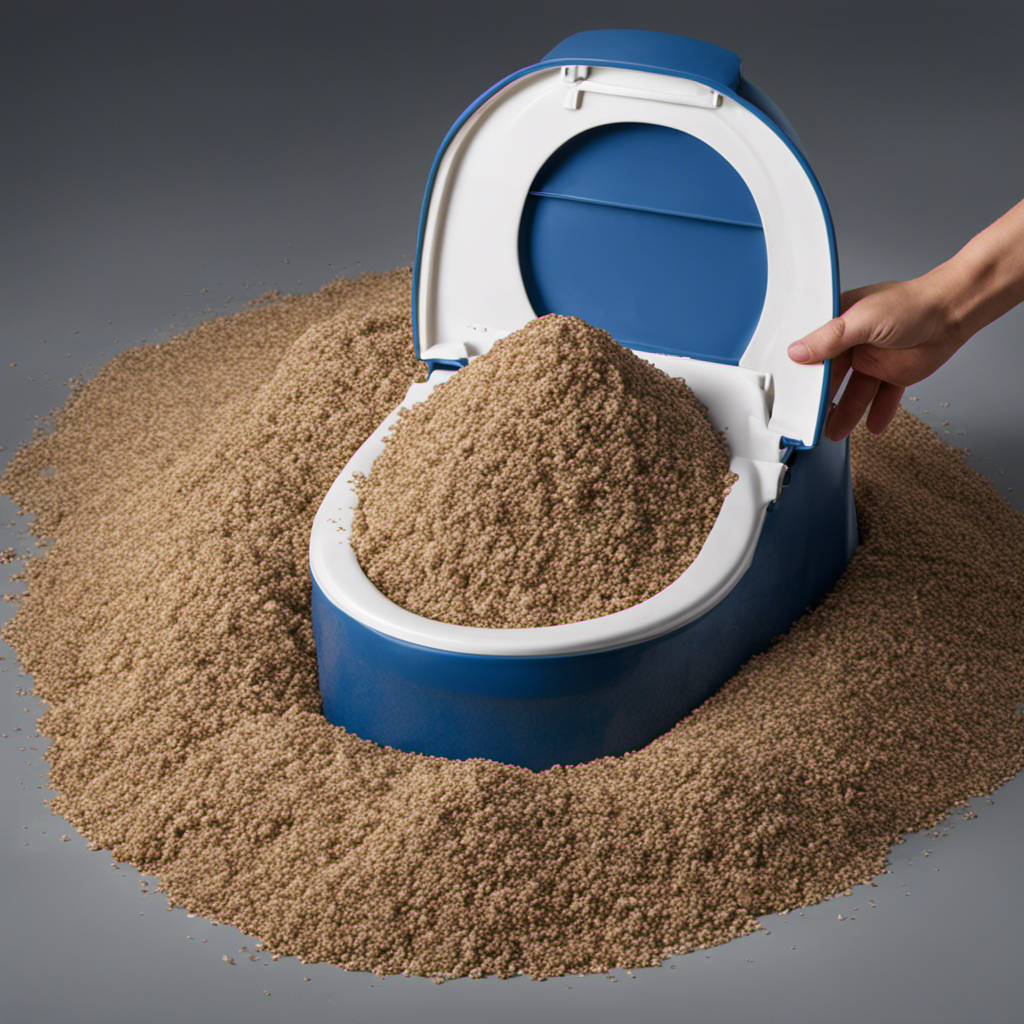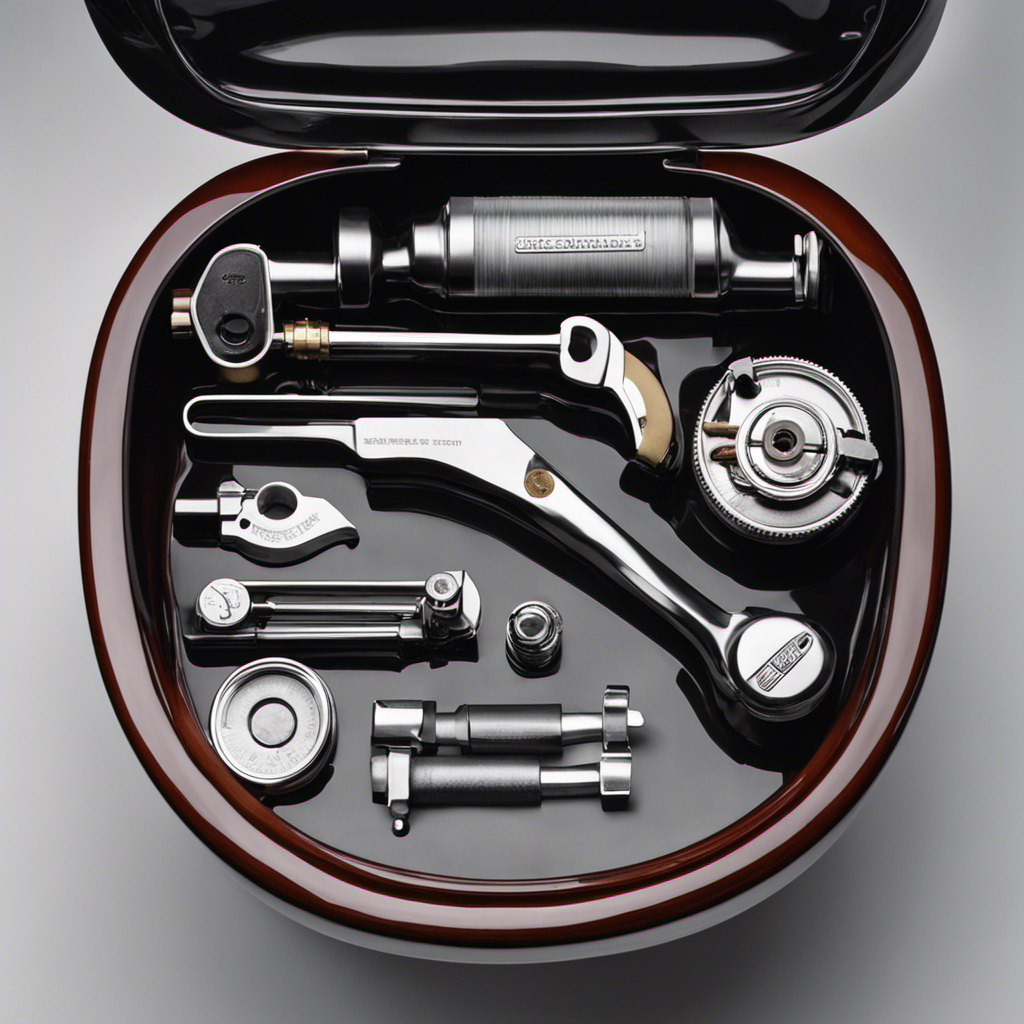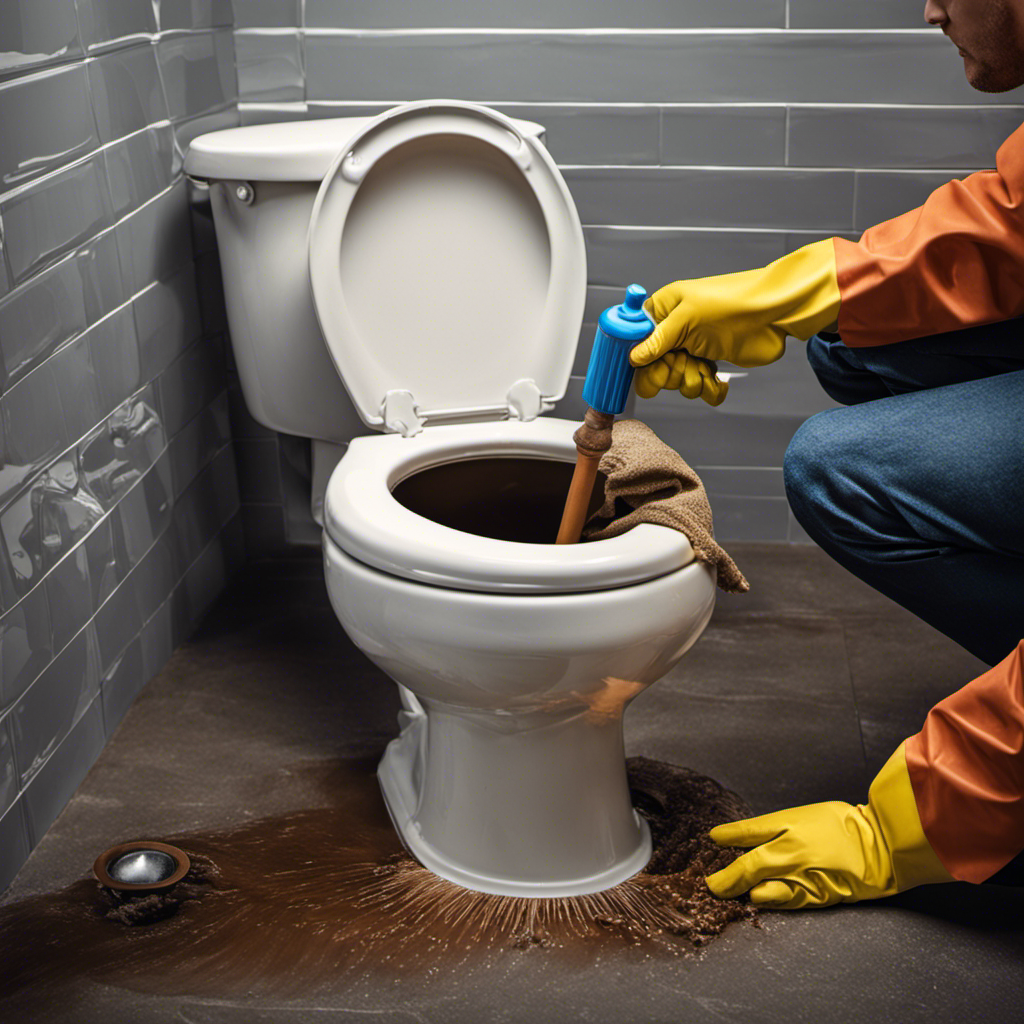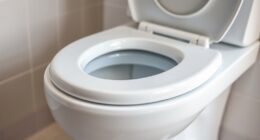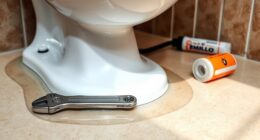Did you know that flushing cat litter down the toilet can lead to costly and inconvenient plumbing problems? It’s true! When cat litter absorbs liquid, like cat feces and urine, it can quickly become too big for the narrow pipes in our bathrooms.
Not only that, but cat litter can stick to the drains and cause blockages. In this article, I will explore the dangers of flushing cat litter, the environmental impact, and provide proper methods for disposal.
So let’s dive in and learn how to avoid these risks and keep our plumbing running smoothly.
Key Takeaways
- Flushing cat litter can cause clogs in bathroom pipes and lead to the need for unclogging.
- Cat litter should be disposed of in the trash can using a biodegradable bag to minimize harm to the environment.
- Different types of cat litter, such as clay, pine, paper, silica gel, and flushable litter, have different characteristics and should not be flushed down the toilet.
- Flushable cat litter can still cause toilet clogs and may pose a slight risk to public health due to the presence of parasites in cat feces.
The Dangers of Flushing Cat Litter
Flushing cat litter can lead to toilet clogs and the need for unclogging, which can cause toilet malfunctions and require immediate attention. There are significant risks associated with flushing cat litter, including the potential for toilet clogs and the health hazards it poses.
When cat litter is flushed, it can accumulate and become too large for the narrow pipes in the bathroom. The water absorption in cat litter makes it greasy and sticky, causing it to stick to the drains and form blockages. Even a small piece of litter can get stuck, leading to the accumulation of waste and debris. Flushing the toilet can cause waste and debris to glue to the newly-formed litter chunks, compromising toilet functionality and requiring unclogging.
Additionally, flushing cat litter can introduce harmful bacteria and parasites, such as Toxoplasma Gondii, into the sewage system, posing health risks to both humans and wildlife. It is crucial to avoid flushing cat litter to prevent these risks and ensure proper toilet functioning.
Environmental Impact of Flushing Cat Litter
Throwing cat litter in the toilet can harm the environment and lead to negative consequences. Here are four reasons why it’s important to avoid flushing cat litter:
-
Toilet bowl contamination: Cat litter contains chemicals and bacteria that can contaminate the water in the toilet bowl. When flushed, these contaminants can enter the sewage system and potentially pollute water sources.
-
Impact on marine life: Flushing cat litter can result in the release of harmful substances into rivers, lakes, and oceans. These substances can have a detrimental effect on marine life, including fish, shellfish, and other aquatic species.
-
Disruption of ecosystems: The introduction of cat litter into water bodies can disrupt the natural balance of ecosystems. It can harm the plants and animals that rely on clean water for survival, leading to a decline in biodiversity.
-
Accumulation of waste: Cat litter doesn’t break down easily and can contribute to clogs in the sewage system. This can lead to costly repairs and maintenance, as well as potential backups and overflows that further harm the environment.
Proper Methods for Disposing of Cat Litter
When it comes to getting rid of cat litter, I prefer to follow the recommended methods for disposal.
Flushing cat litter may seem convenient, but it poses dangers and has a significant environmental impact. Flushing cat litter can cause clogs in the toilet and damage to the plumbing system. The litter absorbs water and can become too large for the narrow pipes, resulting in blockages and the need for unclogging.
Additionally, cat litter contains harmful substances, such as toxoplasma gondii, which can harm fish and wildlife populations. These parasites can also cause illnesses in humans, especially children and pregnant women.
Therefore, it is crucial to dispose of cat litter properly by scooping and bagging it in a biodegradable bag for landfill disposal. This method is not only safer but also reduces the environmental impact of flushing cat litter.
Risks of Flushing Different Types of Cat Litter
I prefer to understand the risks associated with different types of cat litter before deciding how to dispose of it properly. Flushing cat litter can have a significant impact on plumbing, causing clogs and malfunctions in the toilet. Here are the risks of flushing different types of cat litter:
-
Clay litter: This common type of litter absorbs water quickly and can clog the toilet faster than other types. Flushing clay litter is not recommended due to its clogging potential.
-
Pine litter: Derived from wood, pine litter is lighter than clay but doesn’t clump well. It is not flushable and should not be thrown down the drain.
-
Paper litter: While paper litter provides a comfortable litter box for cats, it should not be flushed down the toilet. It absorbs moisture quickly but doesn’t control odor effectively.
-
Silica gel litter: Although silica gel litter doesn’t create dust clouds and traps odor well, it decomposes slowly in toilet water and can contribute to clogs. It should not be flushed.
To properly dispose of cat litter, it is recommended to scoop the litter and put it in a biodegradable bag before throwing it in the trash. Using biodegradable cat litter bags has the added benefit of minimizing harm to the environment.
Alternatives to Flushing Cat Litter
One alternative to flushing cat litter is to use biodegradable bags for proper disposal. These bags are designed to break down naturally over time, reducing their impact on the environment.
When it comes to cat litter, it is important to choose a biodegradable option that is safe for composting. This means selecting a litter that is made from natural materials, such as wood, paper, or plant-based fibers. These types of litter can be safely composted along with the cat waste, helping to reduce waste and provide nutrient-rich soil for plants.
Understanding the Consequences of Flushing Cat Litter
Flushing cat litter down the toilet can lead to clogs and damage to the plumbing system. This practice poses risks to both the toilet and the sewage system. Here are the consequences of flushing cat litter:
-
Clogging toilets: Cat litter is designed to absorb liquid elements, including cat poop and urine. When flushed, it can grow and become too large for bathroom pipes, causing clogs. The width of a toilet drain is usually not sufficient to handle large cat litter clogs.
-
Impact on sewage systems: Cat litter thrives in toilet water because it feeds off of it. Regularly flushing cat litter can lead to toilet clogs, which can extend to the sewage system. This can result in blockages and the need for unclogging.
-
Damage to plumbing: Water absorption in cat litter makes the material greasy and sticky. Moisturized litter can stick to the drains, causing blockages. Even a small piece of litter can get stuck, leading to the accumulation of waste and debris. Flushing the toilet can cause waste and debris to glue to the newly-formed litter chunks.
-
Toilet malfunctions: Sticking to the pipes can result in toilet malfunctions and the need for unclogging. Cat litter can become large enough to form clogs in the drains. When a clog occurs, toilet functionality is compromised and immediate attention is required.
Considering these risks and the impact on sewage systems, it is essential to find alternative and proper ways of disposing of cat litter.
Best Practices for Cat Litter Disposal
Throwing cat litter in the trash can is a more effective and environmentally-friendly option. When it comes to choosing the right cat litter, there are several factors to consider.
First, the type of litter is important. Clay litter is the most popular but can be dusty and doesn’t cover odor well. Pine litter is derived from wood and helps with home odor, but it is not easily found. Paper litter provides a comfortable litter box for cats but doesn’t control odor as well. Silica gel litter effectively absorbs moisture and traps odor, but it becomes heavy in toilet water and can contribute to clogs. Finally, flushable cat litter contains biodegradable components, but it can still clog toilets.
Frequently Asked Questions
Can I Flush Cat Litter Made From Natural Materials Down the Toilet?
No, flushing cat litter made from natural materials down the toilet is not recommended. It can cause clogs in the toilet plumbing and has an adverse environmental impact. Proper disposal in a biodegradable bag in the trash is the better option.
Is It Safe to Flush Cat Litter if It Is Labeled as "Flushable"?
Yes, it is not safe to flush cat litter labeled as ‘flushable’. It can still cause toilet clogs and poses a slight risk to public health. Proper disposal methods for cat litter include using biodegradable bags and throwing it in the trash.
What Are the Potential Health Risks Associated With Flushing Cat Litter?
Flushing cat litter can pose potential health risks and have an environmental impact. The waste contains parasites harmful to fish and wildlife, as well as humans. Proper disposal in a biodegradable bag is recommended.
Can Flushing Cat Litter Harm the Plumbing System in My Home?
Flushing cat litter can wreak havoc on your plumbing system, causing clogs and malfunctions. The environmental impact is also concerning, as flushable litter may not dissolve fast enough, posing risks to public health and wildlife populations.
Are There Any Alternative Methods for Disposing of Cat Litter That Are More Environmentally Friendly?
Eco-friendly alternatives for cat litter disposal include composting options. Composting cat litter can be a safe and environmentally friendly way to manage waste. However, it’s important to research proper composting techniques to ensure the health and safety of your compost pile.
Conclusion
In conclusion, it is imperative to avoid flushing cat litter down the toilet due to the numerous risks and environmental impact associated with this practice. Flushing cat litter can lead to toilet clogs and the need for unclogging, causing inconvenience and potential damage to plumbing systems.
Instead, opt for proper methods of cat litter disposal, such as using biodegradable bags and disposing of it in the trash. Remember, prevention is key to avoiding the hassle and expense of dealing with clogged toilets.
So let’s keep our toilets free from clumps of cat litter and protect our plumbing systems and the environment.
